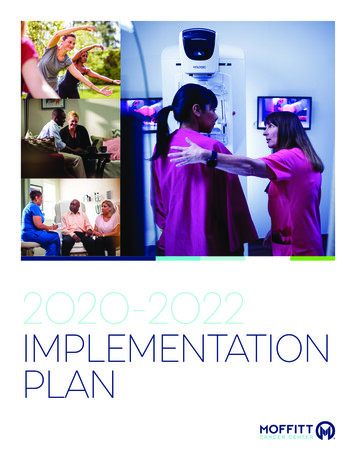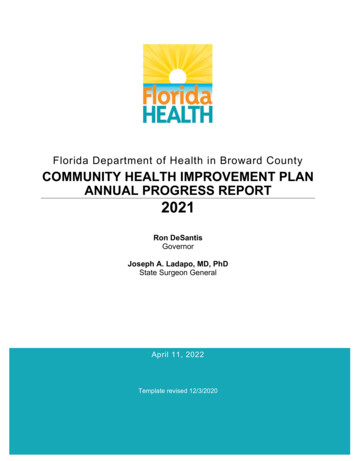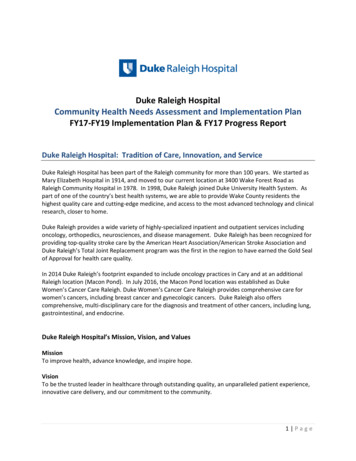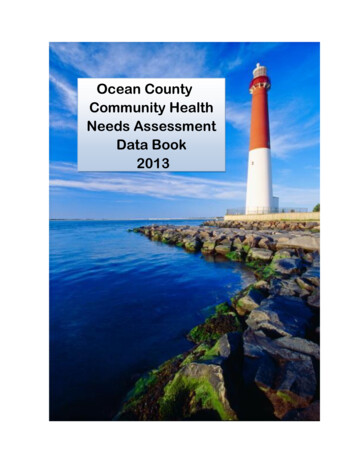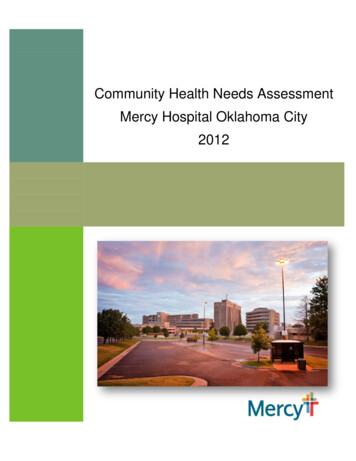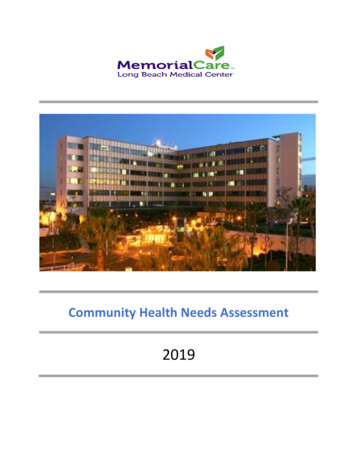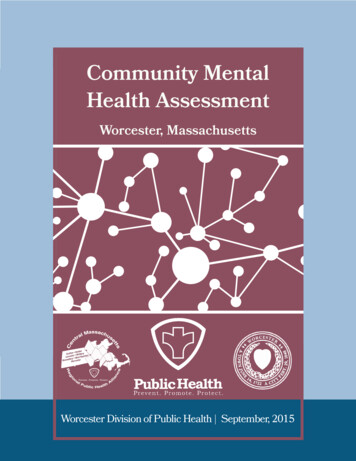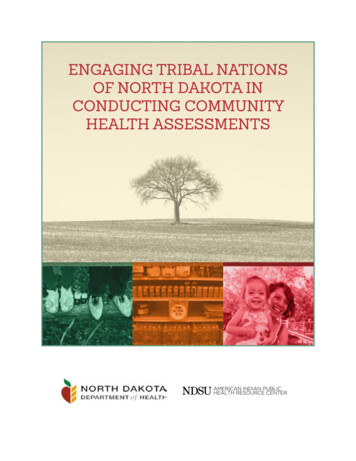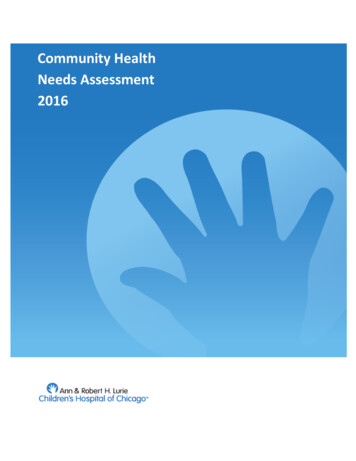
Transcription
Community HealthNeeds Assessment2016
Lurie Children’s CHNA, page 2
ContentsExecutive Summary. 4Introduction . 5CHNA Purpose and Goals . 5The CHNA Process . 5About Lurie Children’s . 11Data and Methods . 12Mortality Data . 12Hospitalization and Emergency Department Visits. 13Chicago Youth Risk Behavior Survey . 13Chicago Homicide Data . 13Child Opportunity Index . 13Prioritized Needs Assessment . 15Population Level Priorities . 15I. Social Determinants of Health . 15II. Access to Care . 17Health Outcome Specific Priorities . 19I. Mental Health . 19II. Obesity, Physical Activity and Nutrition. 20III. Complex Chronic Conditions (CCC) . 21IV. Violence Related Injury and Mortality. 22V. Asthma . 25VI. Child Abuse . 26Recommendations . 27Appendix A: Key Child Population Characteristics in Chicago . 28Appendix B: Overview of Child and Adolescent Mortality and Morbidity in Chicago . 29Appendix C: Existing Resources . 32Lurie Children’s CHNA, page 3
Executive SummaryAnn & Robert H. Lurie Children’s Hospital of Chicago (Lurie Children’s, formerly Children’s MemorialHospital) conducted a community health needs assessment in 2015 and 2016 in order to (1) identifybarriers to good health and well-being for Chicago children and adolescents and (2) guide continuingefforts by Lurie Children’s to improve child and adolescent health and well-being in Chicago.The Lurie Children’s community health needs assessment (CHNA) process involved several activities,which were overseen by the CHNA Committee. The CHNA Committee was comprised of key LurieChildren’s staff, representatives of public health agencies, organizations that serve communities inChicago that experience health disparities, and Lurie Children’s patient population.The Lurie Children’s CHNA makes use of a wide range of data sources, including: US Census, Illinois VitalStatistics, the Illinois Hospital Discharge Data System (or COMPData), and the Chicago Youth RiskBehavior Survey.Key findings from the community health needs assessment are:(1) Social determinants of health greatly affect child health outcomes and need to be consideredwhen working towards making progress on many of our health priorities from reducing violenceto managing asthma.(2) Access to care plays a significant role in overall child-wellbeing and must be addressed in orderto make improvements.(3) While data show that mental health is a leading cause of hospitalization for children andadolescents, access to services in the community is limited. This access issue has been furtherexacerbated recently by the state budget impasse. Particular attention needs to be paid toincreasing services over the next several years.(4) Violence in the City of Chicago remains prevalent and its effects on children are both direct andindirect.(5) Significant interconnectedness exists between all of the above highlighted key findings.Implementation strategies that address underlying causes of the health outcomes or multiplefactors will be prioritized.Lurie Children’s CHNA, page 4
IntroductionAnn & Robert H. Lurie Children’s Hospital of Chicago (Lurie Children’s, formerly Children’s MemorialHospital) conducted a community health needs assessment (CHNA) in 2015 and 2016 in order to (1)identify barriers to good health and well-being for Chicago children and adolescents and (2) guidecontinuing efforts by Lurie Children’s to improve child and adolescent health and well-being in Chicago.This document reviews the process to produce this CHNA, presents the community health needsassessment, and makes broad recommendations that will guide Lurie Children’s continuing efforts toimprove the health and well-being of Chicago children and adolescents.The City of Chicago is the primary geographic area that is the focus of this CHNA, the city that has beenhome to Lurie Children’s throughout its 130 year history. However, because Lurie Children’s serveschildren and adolescents across Illinois (especially those with medically complex conditions who cannotreceive care at their community hospital) and often works to improve the public health of childrenacross Illinois, the CHNA will consider health needs outside of Chicago, where appropriate.CHNA Purpose and GoalsEach year, Lurie Children’s makes significant investments in community health needs assessment andevaluation. The current CHNA works to build stronger connections to Lurie Children’s organizationalplanning processes, evaluate community health needs, and report on current community health needsand efforts. The goals of the CHNA are to:1. Identify areas of high need, in order to prevent death and hospitalization for children andadolescents in Chicago and served by Lurie Children’s;2. Set priorities and goals using evidence as a guide for decision-making; and3. Implement programs, policies, and advocacy efforts, in order to better serve Lurie Children’spatients and improve the health and well-being of the community.The findings of the community health needs assessment are outlined in this report; a subsequent reportwill detail the implementation plan that is driven by evidence collected from the Chicago community.The CHNA ProcessLurie Children’s CHNA builds on a long history of public health focus on the part of the hospital.Beginning as early as the 1980s, Lurie Children’s has embraced significant public health goals under theguidance of its Board of Directors. These goals include efforts to prevent prevalent risks to children andadolescents in Chicago and Illinois, such as: child abuse, firearm injury, community violence, childhoodunintentional injury, HIV/AIDS, and childhood obesity. In the 1980’s, Lurie Children’s also developed thefirst practice-based research collaborative for pediatrics in the United States. The Pediatric PracticeResearch Group now includes over 70 pediatric practices in Chicago and its suburbs. In addition toLurie Children’s CHNA, page 5
conducting research, has served as a conduit for both the development of high quality pediatric careacross the region and for community-focused interventions (such as improved lead screening, improvedasthma management, improved childhood obesity screening and treatment, and public health needsassessment).In preparing to conduct the CHNA, Lurie Children’s followed the recommendations that had beenapproved by the Lurie Children’s Board of Directors in 2012 during the first CHNA process. In addition todeveloping a plan to conduct the community health needs assessment itself, the recommendations alsoincluded refining internal processes at Lurie Children’s to assure that the CHNA, and the programsguided by it, are well-integrated into Lurie Children’s efforts to meet its mission. Theserecommendations are as follows:(1) Build stronger connections between Lurie Children’s community-focused efforts and ourinternal organizational planning process;(2) Systematize and coordinate the many disparate community health needs assessmentactivities and programs that clinicians and researchers at Lurie Children’s undertake; and(3) Establish a more predictable mechanism for reporting community-focused activities to theLurie Children’s Board of Directors.Table 1: Draft timeline for completion of the Lurie Children’s community health needs assessmentDateMilestoneResponsible groupSeptember 2015Convene CHNA Committee; receive updates on 2013 CHNA Committeeimplementation planNovember 2015Review leading causes of death and hospitalizationCHNA Committeedata; receive updates on 2013 implementation planFebruary 2016Presentation on Child Opportunity Index; receiveCHNA Committeeupdates on 2013 implementation planApril 2016Review data on health priorities from 2013 CHNACHNA CommitteeJune 2016Review additional data; select health prioritiesCHNA CommitteeJuly 2016Finalize CHNA; approval from Public PolicyCHNA CommitteeCommitteeNovember 2016Draft and review implementation plan with PublicCHNA CommitteePolicy Committee for approvalLurie Children’s CHNA, page 6
Table 2: Lurie Children’s CHNA Committee MembersMemberLurie Children’s staffMonica Heenan, Senior Vice President/Chief StrategyOfficerRoleExpertiseSenior ManagementOversees Lurie Children’s case managementprogram and other programs that focus onlinking children with medical complexity tocommunity support servicesOversees all external affairs efforts for LurieChildren’sDirects Lurie Children’s Nursing activitiesDirects a multi-pronged Lurie Children’ssponsored program to reduce injury toChicago children and adolescentsDirects the Smith Child Health ResearchProgram, which has grants and programsthat address a variety of issues includingprevention of violence, injuries, obesity andunderage drinkingDirects a Lurie Children’s-sponsored programto reduce violence in Chicago as well as helpsto set the strategic direction for LurieChildren’s Injury Prevention and ResearchCenterDirects a Lurie Children’s-sponsored programto reduce childhood obesity in Chicago,which has become a national model forother citiesDirects a primary care clinic in a low incomeand racially and ethnically diversecommunity in Chicago; specializes in primarycare for medically complex childrenSusan Hayes Gordon, Senior Vice President/Chief,Marketing and External AffairsBrian Stahulak, Chief Nurse OfficerKaren Sheehan, MD, MPH, Associate Chair for Advocacy,Department of Pediatrics, Feinberg School of MedicineSenior ManagementMatt Davis, MD, MPH, Director, Smith Child HealthResearch ProgramPublic Health ExpertRebecca Levin, MPH, Strategic Director, Injury Preventionand Research Center; Director, Strengthening Chicago’sYouth (SCY)Public Health ExpertAdam Becker, PhD, Executive Director, Consortium toLower Obesity in Chicago ChildrenPublic Health ExpertBarbara Bayldon, MD, Primary Care Section Chair,Department of Pediatrics, Feinberg School of MedicinePrimary care provider for themedically underservedLurie Children’s CHNA, page 7Senior ManagementPublic Health Expert
MemberExternal representativesBarbara Fischer, Section Chief, Public Reporting andTransparency, Division of Patient Safety and Quality,Illinois Department of Public HealthRoleExpertisePublic Health ExpertProvides substantial experience in publichealth initiatives focused on maternal,infant, and child healthEsther Corpuz, Chief Executive Officer, Alivio MedicalCenterPublic Health ExpertNikhil Prachand, MPH, Director of Epidemiology, ChicagoDepartment of Public Health (CDPH)Public Health Data Expert in theCity of ChicagoSheri Cohen, MPH, Senior Health Planning Analyst,Chicago Department of Public HealthTeri Merens, MD, Physician at Traismans, Benuck, Merens& KimballBernice Mills Thomas, RN, MSN, MPH, MBA, ExecutiveDirector, Near North Health Services CorporationPublic Health ExpertPamela Spadino, Lurie Children’s Family Advisory BoardParent of Lurie Children’spatientEric Schroeder, Lurie Children’s Family Advisory BoardParent of Lurie Children’spatientPatientDirects all aspects of Alivio Medical Center, aFederally Qualified Health Center;community leaderDirects the CDPH analytics and epidemiologyprogram; conversant in all public health datafocused on child healthDecades of experience in health policy andplanning at the city levelExtensive experience delivering health carein a community-level primary care settingDirects all aspects of a multi-site FederallyQualified Health Center, Near North HealthServices CorporationFormer chair of the Lurie Children’s FamilyAdvisory Board and a parent of a child withmedical complexityPresident of the Family Advisory BoardAJ Williams, Lurie Children’s Kids Advisory Board MemberTim Weaver, Lurie Children’s Kids Advisory BoardMemberLurie Children’s CHNA, page 8Community PhysicianPublic Health ExpertPatientMember of the Lurie Children’s Kids AdvisoryBoardMember of the Lurie Children’s Kids AdvisoryBoard
MemberStaff SupportJill Fraggos, MPH, Director, Government AffairsJenifer Cartland, PhD, Data Analytics and ReportingTracie Smith, MPH, Director, Population Health AnalyticsJames P. Harisiades, MPH, Director, Child AdvocacyMary Kate Daly, Senior Director, Communications andExternal Affairs, Community RelationsReagen Atwood, Associate General Counsel for LurieChildren’sLori Lorgeree, Tax Compliance Consultant for LurieChildren’sEmily Levin, MHA, Administrative FellowLurie Children’s CHNA, page 9RoleCommunity Advocacy ExpertDirects Data Analytics andReportingPublic Health Data ExpertCommunity Advocacy ExpertCommunity Affairs ExpertLegal ExpertTax ExpertHospital Operations ExpertExpertise
The Lurie Children’s Community Health Needs Assessment process involved several activities: The convening and facilitation of the Community Health Needs Assessment Committee, whichincludes representatives of public health agencies, organizations that serve communities inChicago that experience health disparities, and Lurie Children’s patient population (see Table 2for a list of committee members).The analysis and presentation of community health data by the Child Health Data Lab (CHDL), aresearch unit that is part of Lurie Children’s MaryAnn and J. Milburn Smith Child HealthResearch Program.The CHNA Committee met six times from September 2015 through June 2016. Each meeting focused ona set of key decisions for the CHNA process:Meeting 1:- September 30, 20151. Introduction of the CHNA process and brief to the committee on Lurie Children’s work to date2. Presentation on the Healthy Chicago Hospital Collaborative from Erica Salem, Director of HealthPolicy at Health and Disability Advocates3. Update on Violence Prevention priority from 2013 CHNA from Rebecca Levin, MPH, Director ofStrengthening Chicago’s Youth4. Update on Sports and Outdoor Activities priority from 2013 CHNA from Cynthia LaBella, MD,Medical Director of the Institute for Sports Medicine at Lurie Children’sMeeting 2: November 24, 20151. Review of mortality, hospitalization, and emergency department use data for Chicago andIllinois2. Presentation from Jaime Dirksen, Managing Deputy Director of Chicago Department of PublicHealth, on the Healthy Chicago 2.0 (City of Chicago Community Health Needs Assessment)process3. Update on Unintentional Injury Prevention priority from 2013 CHNA from Karen Sheehan, MD,MPH, Emergency Department physician and Medical Director of the Injury Prevention andResearch Center4. Review of timeline for CHNA completionMeeting 3: February 24, 20161. Update on Obesity Prevention priority from 2013 CHNA from Adam Becker, PhD, ExecutiveDirector of the Consortium to Lower Obesity in Chicago Children (CLOCC)2. Update on Care Coordination for Medically Complex Children priority from 2013 CHNA fromChris Haen, Executive Director, Lurie Children’s Health Partners Care Coordination3. Presentation on Illinois’ Child Health Policy Campaign by Susan Hayes Gordon, Chief/Senior VicePresident of Marketing and External AffairsLurie Children’s CHNA, page 10
4. Presentation on the Child Opportunity Index by Tracie Smith, MPH, Director of PopulationHealth Analytics at Lurie Children’sMeeting 4: April 20, 20161. Presentation on Children’s Health Alliance of Wisconsin and Democracy Collaborative by JillFraggos, MPH, Senior Director of Government Affairs2. Review of Emergency Department and Hospitalization data for priorities from 2013 data overtime, by gender, by age group, by race/ethnicity and by Child Opportunity Index level3. Update on Lurie Children’s participation in Chicago Community Trust’s On the Table ListeningSessions and Child Health Steering CommitteeMeeting 5: June 7, 20161. Review of revised and additional data2. Discussion of prioritization of needs based on review of data3. Discussion on how best to include Social Determinants of Health and Access to CareMeeting 6: July 13, 20161. Review and feedback for Community Health Needs Assessment draft2. Discussion and consensus on key findings3. Discussion and consensus on recommendationsAbout Lurie Children’sLurie Children’s is an Illinois not-for-profit corporation and a charitable organization within the meaningof Section 501(c)(3) of the Internal Revenue Code. Lurie Children's is a pediatric hospital with 288licensed inpatient beds. It provides superior pediatric care in a setting that offers the latest benefits andinnovations in medical technology, research and family-friendly design. It is the largest pediatricprovider in the region with 1,353 medical staff in 70 pediatric specialties serving over 174,000 patientsannually.Lurie Children’s commitment to serve children in Chicago and Illinois is at the core of its Mission, whichhighlights four priorities that drive all of Lurie Children’s efforts in the hospital and in the community:1.2.3.4.Pediatric health care delivery;Research into the prevention, causes, and treatment of diseases that affect children;Education for physicians, nurses, and allied health professionals; andAdvocacy for the general well-being of all children.Lurie Children’s has long used community-based needs assessment processes to guide its efforts toimprove the overall health and wellness of Chicago children and adolescents. In 1998, Lurie Children’sestablished the Child Health Data Lab (CHDL) to bring together needs assessment for Lurie Children’sLurie Children’s CHNA, page 11
community-based efforts and to evaluate the hospital’s community-based interventions. Today, CHDLcontinues to produce reports that focus on injury, but has expanded these to also address youth riskbehaviors, access to medical care, causes of infant mortality, and other topics that identify health needsof children and adolescents in Chicago and Illinois. Areas of focus have evolved out of conversationswith governmental and non-governmental partners, as well as feedback from parents of Lurie Children’spatients.Data and MethodsThe CHNA draws data from a wide range of sources, taking advantage of data collected by public healthagencies wherever possible. The CHNA makes heavy use of Illinois mortality data, the Illinois HospitalDischarge Data System (or COMPData), and the Chicago Youth Risk Behavior Survey. Each data source isdescribed in detail below.In conducting this analysis, it was determined that nearly 44% of the patients cared for at LurieChildren’s are residents of the City of Chicago. Given this and the fact that the City of Chicago is thehome of Lurie Children’s, it was decided to define the community for the purposes of the assessment asthe City of Chicago. For issues related to medically complex children, the community is defined as theState of Illinois, given that this population of children served at Lurie Children’s travel from every cornerof the State.In line with good public health practice, the CHNA analysis began with a review of the leading causes ofdeath and hospitalization for Chicago and Illinois children and adolescents to assure that the full rangeof serious health risks was considered. Once major health risks were identified, a deeper analysis wasconducted. The analysis resulted in the identification of two population level priorities and six majorhealth risks to children and adolescents in Chicago.The population level priorities and major health risks became the focus of the eight “Prioritized NeedsAssessments.” Other data sources were used to identify opportunities for preventability and/ortargeted identification of the populations at highest risk (for example, certain age groups, certain racialor ethnic groups, and children living in certain neighborhoods) for each of the six major health risks. TheCHNA Committee reviewed the data and provided input based upon each individual’s expertise,knowledge and experience, concerning the scope and severity, urgency, feasibility and potentialeffectiveness of possible interventions. The CHNA Committee also reviewed available resources toprovide pediatric health care resources to the general community and to address the specific areas ofmajor health risk for children. These resources are outlined in Appendix A.Mortality DataData describing causes of death were received from the vital statistic files from the Chicago Departmentof Public Health for year 2014. Rates were calculated using 2010 US Census data.Lurie Children’s CHNA, page 12
Hospitalization and Emergency Department VisitsHospitalization data, including emergency department visits and inpatient admissions, were obtainedfrom the Illinois hospital discharge database, COMPData, which is maintained by the Illinois HospitalAssociation. Hospitalization cases include children and adolescents of ages 0 to 19 years who weredischarged in calendar year 2009-2014. Excluded cases were those who were deceased and those notliving in Illinois. Rates were calculated using 2010 US Census data.Chicago Youth Risk Behavior SurveyThe Chicago Youth Risk Behavior Survey (YRBS) was completed in randomly selected public high schoolsin Chicago during the spring of 2013. The survey focuses on priority health-risk behaviors that result inthe most significant mortality, disability, and social problems during both adolescence and adulthood.Questions cover nutrition, tobacco use, alcohol and other drug use, physical activity, injuries, and sexualbehavior resulting in sexually transmitted diseases and pregnancy. YRBS is one component of the YouthRisk Behavior Surveillance System developed by the Centers for Disease Control and Prevention, incollaboration with representatives from state and local departments of education and health, otherfederal agencies, and national education and health organizations.Chicago Homicide DataHomicide data in this report were obtained from the Red Eye, a subsidiary of the Chicago Tribune, whichtracks homicides and has information dating back to 2006. The Red Eye compiles information from theCook County Medical Examiner’s Office, the Chicago Police Department and the Chicago Breaking NewsCenter. Data elements include address, neighborhood, date and time of the homicide, as well as name,age, gender and race (black or white) and cause of death (e.g., gunshot, stabbing) of the victim.Child Opportunity IndexThe Child Opportunity Index (COI) is a measure of relative opportunity across neighborhoods, and itprovides a means of exploring socio-economic status for children. The COI was developed throughcollaboration between diversitydatakids.org and the Kirwan Institute for the Study of Race and Ethnicity.The index includes three sub-indices: Educational Opportunity Index, Health and EnvironmentalOpportunity Index and the Social and Economic Opportunity Index. See Table 3 for the metrics thatcomprise the index. More detailed information about the Child Opportunity Index can be found OCS/DDK KIRWAN CHILDOI OVERVIEW.pdf.The Chicago Department of Public Health provided Lurie Children’s with COI scores. Higher COI scorescorrespond to more opportunities that are available for children and youth who live in that zip code.When analyzing health outcomes data, Lurie Children’s calculated rates of a given outcome for each COIlevel and compared those rates to determine which health outcomes had the most distinct healthinequities.Lurie Children’s CHNA, page 13
Table 3. Components of the Child Opportunity Index ScoreEducational Opportunity Adult educational attainmentIndexStudent (school) poverty rateReading proficiency rateMath proficiency rateEarly childhood education neighborhood participation patternsHigh school graduation rateProximity to high-quality1 early childhood education centersProximity to early childhood education centers of any typeHealth andRetail health food indexEnvironmentalProximity to toxic waste release sitesOpportunity IndexVolume of nearby toxic releaseProximity to parks and open spacesHousing vacancy ratesProximity to health care facilitiesEconomic OpportunityNeighborhood foreclosure rateIndexPoverty rateUnemployment ratePublic assistance rateProximity to employment1Accredited by the National Association for the Education of Young Children (NAEYC).Lurie Children’s CHNA, page 14
Prioritized Needs AssessmentThe Prioritized Needs Assessments include two overarching population level topics affecting children’shealth and six specific causes of poor health outcomes for children.Population Level PrioritiesI. Social Determinants of HealthAccording to the World Health Organization, socialdeterminants of health are “the conditions in whichpeople are born, grow, live, work and age.” TheWorld Health Organization argues that socialdeterminants of health “are mostly responsible forhealth inequities.” The Lurie Children’s CommunityHealth Needs Assessment Committee has identifiedsocial determinants of health as a priority area offocus and utilized a tool called the Child OpportunityIndex (COI, see ‘Data and Methods’) in order to betterunderstand the health inequities among children andadolescents in the City of Chicago.Zip codes in the City of Chicago were grouped into oneof five categories of opportunity level. Those classifiedas having low or very low childhood opportunity arerepresented in yellow and red, respectively, in Figure1. The areas in the City of Chicago with the lowest COIlevel are in the far south and far west regions, thoughalmost all of the south and west sides also have atleast a low level of childhood opportunity. In addition,a strong relationship exists between the childhoodopportunity index and race/ethnicity, as shown inFigure 2. About one-third of Lurie Children’s patientslive in an area with low or very low COI.Key PointsAt Highest Risk: Children living in low or very lowopportunity zip codes African-American and Hispanic childrenPreventability Considerations: Interventions should be targeted at socialdeterminants specifically, or take intoaccount the interplay between socialdeterminants and outcomesChild OpportunityIndex LevelFigure 1: COI by zip codeLurie Children’s CHNA, page 15
Figure 2. Proportion of Racial and Ethnic Groups by Child Opportunity Index Level100%80%60%40%20%0%Very LowLowModerateHighBlack, Non-HispanicWhite, Non-HispanicAsian, Non-HispanicOther, Non-HispanicVery HighHispanic (All races)*Data source: American Community Survey, 2010-2014The COI is used throughout this report to explore differences in health outcomes for children andadolescents. Among the health priorities that were selected for inclusion in the CHNA, several showedstrong differentiation based on theFigure 3. Illustration of the difference between Equality andneighborhood COI, pointing to significantEquityhealth inequalities that Lurie Children’sbelieves are driven by socioeconomic inequality(the definition of ‘social determinants ofhealth’). Social determinants of health appearto drive inequities (Figure 3) in violence (whichincludes homicides and intentional injuries),visiting the ED or being hospitalized for anambulatory sensitive care condition, childabuse related injuries, and asthma related EDvisits or hospitalizations.Source: Saskatoon Health Region- Advancing HealthEquityAdditionally, we examined the rate of poverty amongChicago families between 2009 and 2014 and found aslight increase in the percent of families in poverty inChicago (Figure 4). This underscores the need to fo
Bernice Mills Thomas, RN, MSN, MPH, MBA, Executive Director, Near North Health Services Corporation Public Health Expert Directs all aspects of a multi-site Federally Qualified Health Center, Near North Health Services Corporation Pamela Spadino, Lurie hildren's Family Advisory oard Parent of Lurie hildren's patient
